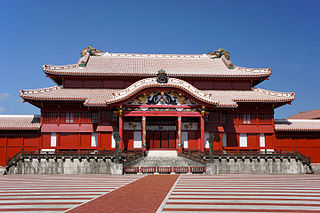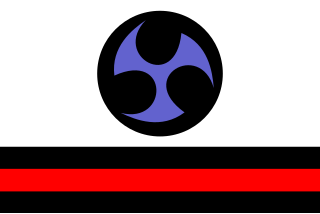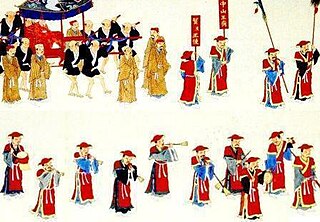| Look up Ryukyu or Ryukyuan in Wiktionary, the free dictionary. |
The Ryukyu Islands are a volcanic arc archipelago.
Ryukyu may also refer to:
- Kingdom of Ryukyu, a former kingdom annexed by the Empire of Japan
- Ryukyuan languages
- Ryukyuan people
| Look up Ryukyu or Ryukyuan in Wiktionary, the free dictionary. |
The Ryukyu Islands are a volcanic arc archipelago.
Ryukyu may also refer to:
| This disambiguation page lists articles associated with the title Ryukyu. If an internal link led you here, you may wish to change the link to point directly to the intended article. |

The Ryukyuan people, also Lewchewan, are an East Asian ethnic group native to the Ryukyu Islands between the islands of Kyushu and Taiwan. Politically, they live in either Okinawa Prefecture or Kagoshima Prefecture. There are different subgroups of the Ryukyuan ethnic group, them being the Okinawan, Amami, Miyako, Yaeyama and Yonaguni peoples. Their languages make up the Ryukyuan languages, considered to be one of the two branches of the Japonic language family, the other being Japanese and its dialects. Hachijō is sometimes considered to be the third branch.

The Ryukyuan languages, also Lewchewan languages, are the indigenous languages of the Ryukyu Islands, the southernmost part of the Japanese archipelago. Along with the Japanese language, they make up the Japonic language family. The languages are not mutually intelligible with each other. It is not known how many speakers of these languages remain, but language shift towards the use of Standard Japanese and dialects like Okinawan Japanese has resulted in these languages becoming endangered; UNESCO labels four of the languages "definitely endangered" and two others "severely endangered".

This article is about the history of the Ryukyu Islands southwest of the main islands of Japan.

The Ryukyu Kingdom was a kingdom in the Ryukyu Islands from 1429 to 1879.

The Amami Islands is an archipelago in the Satsunan Islands, which is part of the Ryukyu Islands, and is southwest of Kyushu. Administratively, the group belongs to Kagoshima Prefecture, Japan. The Geospatial Information Authority of Japan and the Japan Coast Guard agreed on February 15, 2010, to use the name of Amami-guntō (奄美群島) for the Amami Islands. Prior to that, Amami-shotō (奄美諸島) was also used. The name of Amami is probably cognate with Amamikyu (阿摩美久), the goddess of creation in the Ryukyuan creation myth.
Shō Shōken, also known as Haneji Wōji Chōshū, was a Ryukyuan scholar and served as sessei, a post often translated as "prime minister," from 1666 to 1673. Shō wrote the first history of the Ryukyu Kingdom, Chūzan Seikan, and enacted a number of practical political reforms aimed at improving Ryukyu's prosperity and dignity in the eyes of China and Japan.
Sessei (摂政) was the highest government post of the Ryūkyū Kingdom below the king; the sessei served the function of royal or national advisor. In the Ryukyuan language at the time, the pronunciation was closer to shisshii, and has only changed relatively recently. Though the same Chinese characters which compose the modern Okinawan word sessei are read as sesshō in Japanese, the position is not quite the same, and the Ryukyuan post is not derived from the Japanese model or system.

The Ryukyu Islands, also known as the Nansei Islands or the Ryukyu Arc, are a chain of Japanese islands that stretch southwest from Kyushu to Taiwan: the Ōsumi, Tokara, Amami, Okinawa, and Sakishima Islands, with Yonaguni the westernmost. The larger are mostly high islands and the smaller mostly coral. The largest is Okinawa Island.

Chūzan (中山) was one of three kingdoms which controlled Okinawa in the 14th century. Okinawa, previously controlled by a number of local chieftains or lords, loosely bound by a paramount chieftain or king of the entire island, split into these three more solidly defined kingdoms within a few years after 1314; the Sanzan period thus began, and would end roughly one hundred years later, when Chūzan's King Shō Hashi conquered Hokuzan in 1419 and Nanzan in 1429.

Over the course of Japan's Edo period, the Ryūkyū Kingdom sent eighteen missions to Edo, the capital of Tokugawa Japan. The unique pattern of these diplomatic exchanges evolved from models established by the Chinese, but without denoting any predetermined relationship to China or to the Chinese world order. The Kingdom became a vassal to the Japanese feudal domain (han) of Satsuma following Satsuma's 1609 invasion of Ryūkyū, and as such were expected to pay tribute to the shogunate; the missions also served as a great source of prestige for Satsuma, the only han to claim any foreign polity, let alone a kingdom, as its vassal.
Imperial Chinese missions to the Ryukyu Kingdom were diplomatic missions which were intermittently sent by the Yuan, Ming and Qing emperors to Shuri, Okinawa in the Ryukyu Islands. These diplomatic contacts were within the Sinocentric system of bilateral and multinational relationships in East Asia.
Ryukyuan missions to Joseon were diplomatic and trade ventures of the Ryūkyū Kingdom which were intermittently sent in the years 1392–1879. These diplomatic contacts were within the Sinocentric system of bilateral and multinational relationships in East Asia. The Ryukyuan King Satto established formal relations with the Joseon court.

Shō Tei was the 11th King of the Second Shō Dynasty of the Ryukyu Kingdom, who held the throne from 1669 until his death in 1709. He was the ruler of Ryukyu at the time of the compiling of the Chūzan Seifu (中山世譜).

The Okinawan people are a Ryukyuan ethnic group native to the Okinawa Islands of Okinawa Prefecture, Japan.
Joseon missions to Ryukyu Kingdom were diplomatic and trade ventures of the Joseon Dynasty which were intermittently sent after 1392. These diplomatic contacts were within the Sinocentric system of bilateral and multinational relationships in East Asia. The Ryukyuan King Satto established formal relations with the Joseon court.

The Ryukyu Domain was a short-lived domain of Japan, lasting from 1872 to 1879, before becoming the current Okinawa Prefecture and other islands at the Pacific edge of the East China Sea.

Amamikyu, or Amekushin-otome-ōankami (天久臣乙女王御神), is the creation goddess of the Ryukyu Islands in the Ryukyuan religion.
The Ryukyuan diaspora are the Ryukyuan emigrants from the Ryukyu Islands, especially Okinawa Island, and their descendants that reside in a foreign country. The first recorded emigration of Ryukyuans was in the 15th century when they established an exclave at Fuzhou in Ming China. Later, there was a large wave of emigration to Hawaii at the end of the 19th century, followed by a wave to various Pacific islands in the 1920s and multiple migrations to the Americas throughout the 20th century. Ryukyuans became Japanese citizens when Japan annexed the Ryukyu Kingdom in 1879; therefore Ryukyuan immigrants are often labeled as part of the Japanese diaspora.

The Ryukyuan mon was the currency of the Ryukyu Kingdom from 1454 to 1879, when the kingdom was annexed by the Empire of Japan and the currency was replaced by the Japanese yen. The Chinese character for mon is 文, which was widely used in the Chinese-character cultural sphere, e.g. Chinese wén, Vietnamese văn, and Korean mun. The Ryukyuans produced their own coins until the 15th century, but became dependent on Chinese coins until the 19th century when they briefly minted their own coins again. From 1862 the minting was outsourced to Kagoshima City, Satsuma Domain and were based on the Japanese mon. All of the Kagoshima-minted coins bear the phrase "Ryūkyū Tsūhō" (琉球通寳) ; this phrase was written in Seal script on the half shu coin. Despite the annexation of the Ryukyu Kingdom in 1879, these coins continued to circulate within Okinawa Prefecture well into the 1880's as the Ryukyuans were initially unwilling to use Japanese yen coins.
The Yaeyama people are a Ryukyuan subgroup native to the Yaeyama Islands of Okinawa Prefecture, Japan.